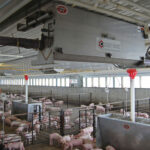Cool Running: Ranching in Alberta’s Cow Country
A pasture sits empty, virtually devoid of anything living, unless you count the grasses, which went dormant months ago as winter set in. While it’s minus 16 Celsius—a relatively balmy winter temperature for Northern Alberta—the wind is howling at about...

Cool Running: Ranching in Alberta’s Cow Country
A pasture sits empty, virtually devoid of anything living, unless you count the grasses, which went dormant months ago as winter set in. While it’s minus 16 Celsius—a relatively balmy winter temperature for Northern Alberta—the wind is howling at about...A pasture sits empty, virtually devoid of anything living, unless you count the grasses, which went dormant months ago as winter set in. While it’s minus 16 Celsius—a relatively balmy winter temperature for Northern Alberta—the wind is howling at about 50 kph and shooting cold like darts into any exposed skin.
Even the cattle up here don’t venture into the open. They choose instead the shelter offered by a sizable stand of poplar and spruce trees. That is, until they hear the tractor.
Like some sort of dinner bell, the sound of the engine bounces off the frosted landscape and calls the cows from the bush. Some 600 cows and a few calves—just one group from a herd that numbers as much as 11,000—barrel forth and line up, ready for mealtime, before they head back to the refuge of the trees.
The Cattlemen who raise them, Chris Sloan and his brother Frankie, and their father, Frank, run Sloan Cattle Company, a cow/calf operation north of St. Paul, Alberta. With some 30,000 acres owned or managed by them, they believe their ranch is among the 20 largest such concerns in Canada.
Comparisons aside, theirs is a demanding job. The Sloans’ pastureland is spread over some 130 km, while the land on which they grow hay—producing as much as 35,000 round bales in years past—is as far away as 150 km.
“One of the challenges of having [so many] cows,” says Chris, “is finding the feed for them. We fight as hard as we can to graze six months out of the year and feed six months. That’s why we make so much hay and bale so much straw,” as many as 1,000 bales a day, adds Chris. They cut and bale that hay with a combination of Massey Ferguson tractors, and Hesston windrowers and large square balers—all tough enough to handle harsh conditions and long hours in the field.
Even though prices are good now, market pressures are always a concern for ranchers, as they are for farmers. Still, says Chris, “The cattle industry really seems optimistic now.”
It’s a lifestyle the three Sloans absolutely love. “I like working with these two and seeing them grow up on the farm,” says Frank about his sons. “And it’s an awful nice sight to see 650 cows lining up, eating their oats behind a spreader. There’s satisfaction in knowing that you’ve done that … that you’ve raised that food for the whole world.”
For more, see http://www.myfarmlife.com/features/cool-running-ranching-in-albertas-cow-country.



